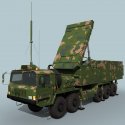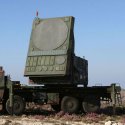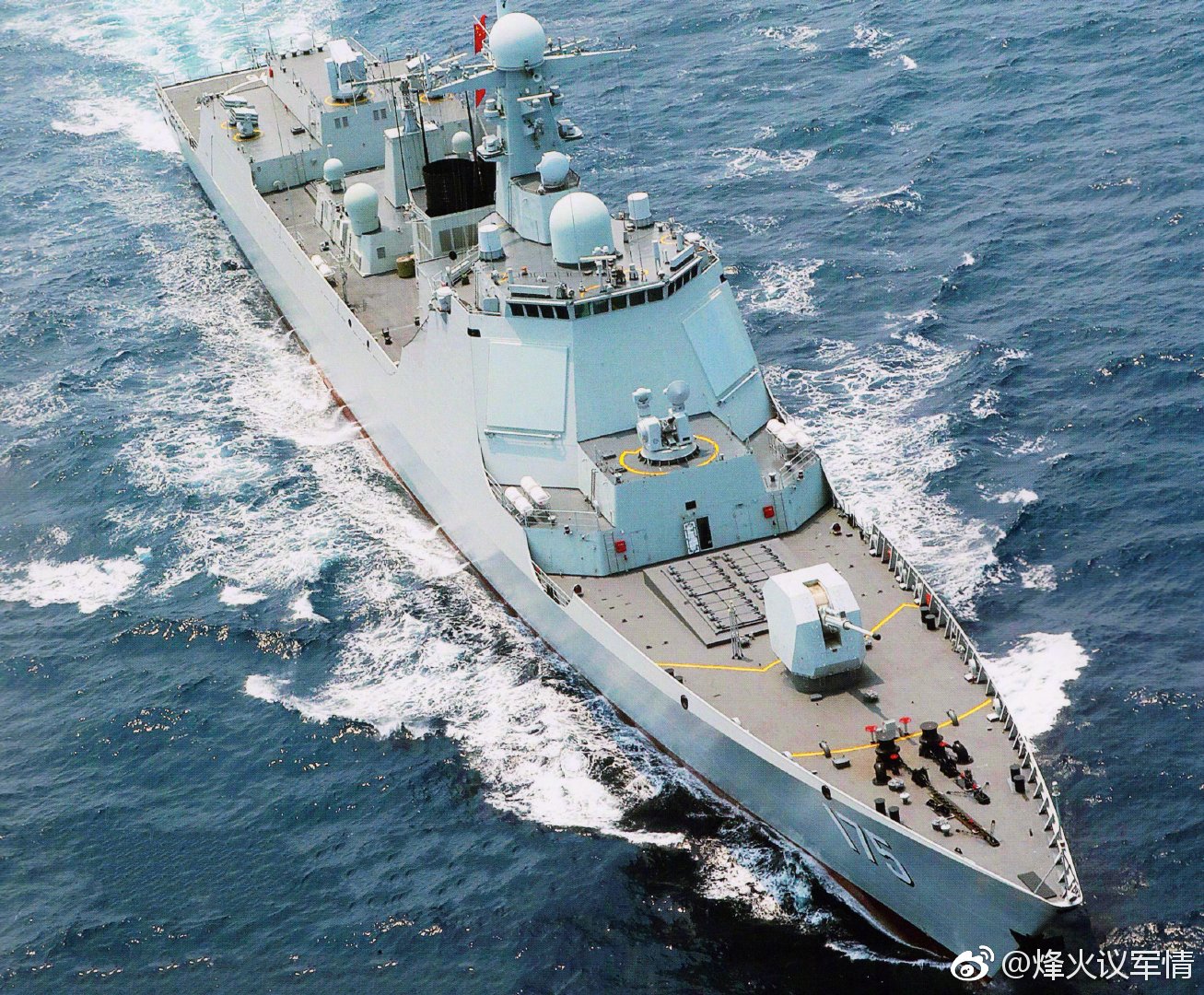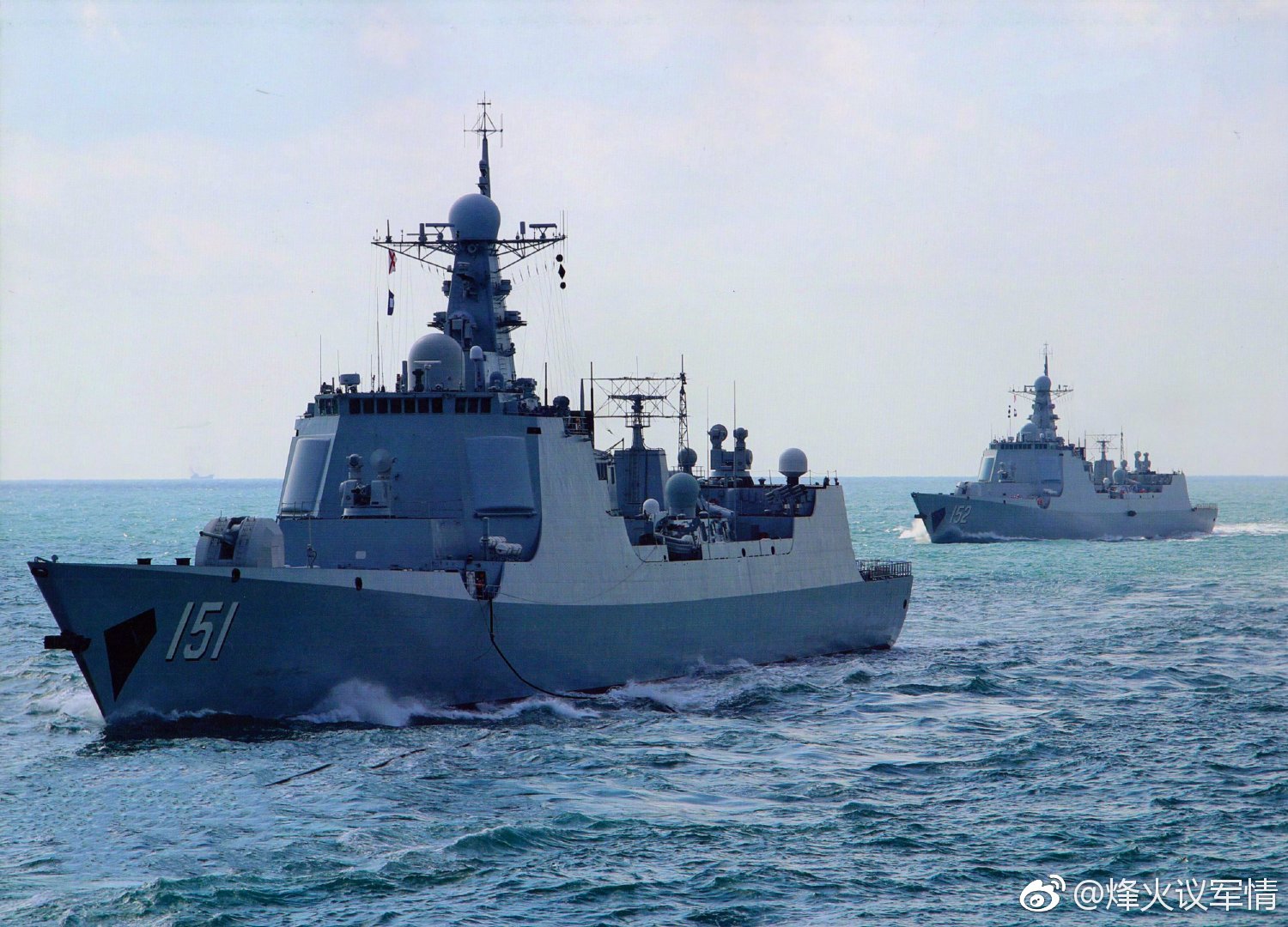You are using an out of date browser. It may not display this or other websites correctly.
You should upgrade or use an alternative browser.
You should upgrade or use an alternative browser.
052C/052D Class Destroyers
- Thread starter Jeff Head
- Start date
I suppose HQ-9 is an ARH missile from the beginning.
I didn't think it was ARH at the beginning due to having the HT-233 FCR, and ARH wasn't good enough to replace SARH until ARH reached a certain level of development. Another that HQ-9 appears strongly inspired or copied from both the PAC and S-300 systems, and both PAC and S-300 used TVM. However, like in the case of the S-400 or RIF-M using the 9M96 missile family, which is an ARH, the FCR can provide more accurate tracking of the target, and this can be used to update the midphase stage of an ARH missile. ARH is only active and autonomous at the last or terminal stage of flight, for the rest of the flight before this, something has to tell the missile where to fly so it can come close enough to the target to catch the target in the seeker's "basket" when the seeker goes active.
I didn't think it was ARH at the beginning due to having the HT-233 FCR, and ARH wasn't good enough to replace SARH until ARH reached a certain level of development. Another that HQ-9 appears strongly inspired or copied from both the PAC and S-300 systems, and both PAC and S-300 used TVM. However, like in the case of the S-400 or RIF-M using the 9M96 missile family, which is an ARH, the FCR can provide more accurate tracking of the target, and this can be used to update the midphase stage of an ARH missile. ARH is only active and autonomous at the last or terminal stage of flight, for the rest of the flight before this, something has to tell the missile where to fly so it can come close enough to the target to catch the target in the seeker's "basket" when the seeker goes active.

The board has made it clear and you have also mentioned a similar board in your post.
View attachment 51286
The board has made it clear and you have also mentioned a similar board in your post.
Indeed, but the FD2000 may not be the base or initial or original version of the HQ-9. HQ-9 was first introduced in 1999, but the FD2000 didn't show up until 2010 in the 8th Zhuhai exhibition, so we can assume this was when the ARH version of the HQ-9 was introduced. The first 052C was launched in 2003, but Type 052D was launched in 2012, so the FD2000 and its ARH seeker lines up well in chronology with the 052D.
I would also believe that the ARH technology is connected or rooted in connection with the PL-12, and only until the PL-12 proved the Chinese rendition of this technology to work, before it would spread to other missiles. The SD-10 was also introduced around 2010 in the same exhibit as the FD2000, so 2010 is a good time point to mark when Chinese ARH technology has matured.
Last edited:
Do you have a link that goes into more detail how the AEGIS FCR system operates?Unlike true FCRs, SPG-62 only lights the target, and does not receive echoes and back and processes the information.
It makes me wonder how the SPG-62 maintains the lock on target if it doesn't receive an echo. The SPY-1 can't either since its S-band. That then leaves just the missile(s). But then the missiles have to relay back the info to AEGIS fire control to close the control loop on the FCR. So it starts to look like TVM.
CMANO doesn't model it as a simple CW radar, but ICWI:
That would give it then both target speed and range information which should help with maintaining target lock.
Going back to Type 346. One thing that bugs is me is why would they go into so much effort developing a completely new radar for what is essentially the same missile as HQ-9, when they already had the HT-233 combining both FCR and search. The end result is a rectangular array not unlike HT-233/Tombstone, just somewhat bigger in surface. If you look at the Russian Naval variants of the S-300, they are close analagoues of the land systems.
CMANO models the HT-233 as a derivative of Tombstone: with all the features that you enumerated.
So far, the arguments for S-band are:
1) Wiki article that showed up in 2016ish
2) Observation that most other PLAN vessels have a S-band search radar
3) Inspired by SPY-1 (but yet different in so many aspects)
Arguments for C-band:
1) Uses same missile as land based HQ-9
2) Shape of array resembles HT-233/Tombstone
3) Both of the above have FCR and search capability
4) Much easier to upscale the proven HT-233 and improve upon search capability then develop a completely new dual-band radar with unusual I-shaped FCR strip (how does that focus the beam in 2 dimensions?)
Finally, C-band and S-band are not that far apart in spectrum. As far as I gathered, the advantage of S-band over say X-band is not in maximum effective range, but rather in being less susceptible to adverse weather conditions. Higher frequency radar waves are attenutated more by water particles found in fog, rain and such.
If you look at very long range US radars, for tracking ballistic missiles and warheads, they are mostly all X-band. AN/TPY-2 radar is claimed to have a range in excess of 2000km against a ballistic missile, and at least 750km against a warhead with RCS of 0.01m2.
Do you have a link that goes into more detail how the AEGIS FCR system operates?
It makes me wonder how the SPG-62 maintains the lock on target if it doesn't receive an echo. The SPY-1 can't either since its S-band. That then leaves just the missile(s). But then the missiles have to relay back the info to AEGIS fire control to close the control loop on the FCR. So it starts to look like TVM.
CMANO doesn't model it as a simple CW radar, but ICWI:
That would give it then both target speed and range information which should help with maintaining target lock.
Going back to Type 346. One thing that bugs is me is why would they go into so much effort developing a completely new radar for what is essentially the same missile as HQ-9, when they already had the HT-233 combining both FCR and search. The end result is a rectangular array not unlike HT-233/Tombstone, just somewhat bigger in surface. If you look at the Russian Naval variants of the S-300, they are close analagoues of the land systems.
CMANO models the HT-233 as a derivative of Tombstone: with all the features that you enumerated.
So far, the arguments for S-band are:
1) Wiki article that showed up in 2016ish
2) Observation that most other PLAN vessels have a S-band search radar
3) Inspired by SPY-1 (but yet different in so many aspects)
Arguments for C-band:
1) Uses same missile as land based HQ-9
2) Shape of array resembles HT-233/Tombstone
3) Both of the above have FCR and search capability
4) Much easier to upscale the proven HT-233 and improve upon search capability then develop a completely new dual-band radar with unusual I-shaped FCR strip (how does that focus the beam in 2 dimensions?)
Finally, C-band and S-band are not that far apart in spectrum. As far as I gathered, the advantage of S-band over say X-band is not in maximum effective range, but rather in being less susceptible to adverse weather conditions. Higher frequency radar waves are attenutated more by water particles found in fog, rain and such.
If you look at very long range US radars, for tracking ballistic missiles and warheads, they are mostly all X-band. AN/TPY-2 radar is claimed to have a range in excess of 2000km against a ballistic missile, and at least 750km against a warhead with RCS of 0.01m2.
In future can you take your how a SPY-1 works and what a dumb ass simulator does or doesn't do questions to a more appropriate thread instead of clogging up this one clearly how a USN battle management system works has no relevance to a thread about a Chinese destroyer.
In simple terms a SPG-62 is an illuminator it sends out a CW signal which bounces off the target received by the SARH seeker in a SM-2's nose which homes in on it. The SPY-1 searches for targets acquires threats the AEGIS computers prioritises the threats sends up missiles (current doctrine calls for 2) when the missiles get to the terminal phase of the engagement the battle management system points a SPG-62 at the target (using info from the SPY-1) lights it up, the SM-2's homes in when it gets close enough the proximity fuse triggers the warhead,.boom, the SPG-62 is then tasked to point at the next threat prioritised by AEGIS using data from the SPY-1.
In a simple single vessel no CEC scenario a CG with 4 illuminators can engage 4 targets a DDG with 3 illuminators 3 targets simultaneously, but they can lob up missiles at more targets than 3 or 4 since the illuminators are only needed in the terminal phase of the intercept (the other missiles can be fired at an approximate intercept point corrected using a datalink then home in when the target finally gets illuminated) the AEGIS system does all the calculations to juggle the queuing and sequencing of the interceptions ensuring the targets get illuminated at the right time.
This explanation is intended to address your query, not as a gateway to solicit more questions irrelevant to this thread and further polluting it!
Do you have a link that goes into more detail how the AEGIS FCR system operates?
It makes me wonder how the SPG-62 maintains the lock on target if it doesn't receive an echo. The SPY-1 can't either since its S-band. That then leaves just the missile(s). But then the missiles have to relay back the info to AEGIS fire control to close the control loop on the FCR. So it starts to look like TVM.
CMANO doesn't model it as a simple CW radar, but ICWI:
That would give it then both target speed and range information which should help with maintaining target lock.
Someone already explained it to you. Will explain it again. It is the SPY-1 that maintains the lock on the target and cues the SPG-62 at the target. S-band can do this level of tracking by using the higher frequency spectrum at the edge of the S-band, which would border the C-band, close to 4Ghz. For longer ranged search, the radar should use the longer frequency spectrum at the edge of the S-band close to the border of L-band, close to 2Ghz. In addition you can increase the PRF rate. This requires that the radar's software will have at least two modes, a Scan and Acquire or TWS mode for the longer spectrum and long PRF, and an engagement mode (TT or Target Tracking) for the shorter spectrum and short PRF.
Going back to Type 346. One thing that bugs is me is why would they go into so much effort developing a completely new radar for what is essentially the same missile as HQ-9, when they already had the HT-233 combining both FCR and search. The end result is a rectangular array not unlike HT-233/Tombstone, just somewhat bigger in surface. If you look at the Russian Naval variants of the S-300, they are close analagoues of the land systems.
CMANO models the HT-233 as a derivative of Tombstone: with all the features that you enumerated.
So far, the arguments for S-band are:
1) Wiki article that showed up in 2016ish
2) Observation that most other PLAN vessels have a S-band search radar
3) Inspired by SPY-1 (but yet different in so many aspects)
You forgot --- the use of Type 346 and 346A on the Carriers Liaoning and 002 means these are search radars in the absolute sense, and points to them being S-band. Other S-band radars used on other carriers around the world includes SMART-S Mk2 on the De Gaulle and SPS-48 on the Nimitz class. You don't use a shorter wave radar unless that radar is fire control, like the X-band SPY-3 on the Ford class which is used for the ESSM targeting. Note that the S-band SPY-4 on the Ford class has relatively the same position as the Type 346A radar on the island of Carrier 002.

With ICWI, it was added to the SPG-62 because the newer batch of ESSM and SM-2 are ICWI compatible, and the reason for ESSM and SM-2 being made ICWI compatible is because they were made to work for the Thales APAR which uses ICWI, and followed by the Japanese Akizuki class, whose X-band fire control works the same way, and not the least, the Zumwalt class and the Ford class whose SPY-3 radar also produces ICWI.
Arguments for C-band:
1) Uses same missile as land based HQ-9
2) Shape of array resembles HT-233/Tombstone
3) Both of the above have FCR and search capability
4) Much easier to upscale the proven HT-233 and improve upon search capability then develop a completely new dual-band radar with unusual I-shaped FCR strip (how does that focus the beam in 2 dimensions?)
Upscale the HT-233? You can't use the HT-233 aboard a ship because of this reason.

See that? There is something on the back of the radar. That's the feeder. It projects the radio pulse into the back of the array, and the array acts only as a lens to refract the beam by phase shifting it. This is why this sort of PESA is called a spaced or optical feed PESA. It requires a significant amount of space within the superstructure, which is why, like you see on the Type 051C --- Tombstone is also a spaced PESA --- it is placed outside of the superstructure. It would also mean there is no opaque wall on the back of the radar. Yet this picture shows that the Type 346 does have a wall.

Compare this to this SPY-1, which is not complete yet in adding all its elements and phase shifters.

Once again, for comparison take a look at Flap Lid and the optical feeder at the back.

Finally, C-band and S-band are not that far apart in spectrum.
Actually they are, C-band is twice as short as S-band. A civilian comparison of the two is Wifi 2.4 Ghz vs. Wifi 5Ghz. The former is S-band, the latter at C-band.
As far as I gathered, the advantage of S-band over say X-band is not in maximum effective range, but rather in being less susceptible to adverse weather conditions. Higher frequency radar waves are attenutated more by water particles found in fog, rain and such.
Not really. Only in a perfect vacuum will the X-band match S-band in range when generated at the same power. Radar waves are attenuated by the air itself, and higher frequency waves will attenuate faster than longer frequency. For an X-band to match an S-band at the same range, it would have to generate much greater power.
If you look at very long range US radars, for tracking ballistic missiles and warheads, they are mostly all X-band. AN/TPY-2 radar is claimed to have a range in excess of 2000km against a ballistic missile, and at least 750km against a warhead with RCS of 0.01m2.
That's because X-band is superior over S-band in the rate and resolution of tracking. It could simply produce much more data on the target and resolve more of the target's details, than S-band where the target would look more of a blob. Against an extremely fast moving object, this favors the use of X-band. For this purposes such radars are huge and power consuming. Super long range OTH radars are typically L-band, but can also reach further to UHF and VHF. Here is a very long range AESA here with its huge elements. SMART-L by the way has a ballistic missile detection mod.

Last edited:
Thanks for the clarification Tam! All valid points. I don't want to dwell on the SPY-1, we can continue that in a seperate thread, other than point out that it operates in the range of 3.1 to 3.5 GHz. Please check some of the links I provided.
Just as a thought experiment: if we assume that HT-233 is in the lower range of C-band, then the freq difference would be relatively small to SPY-1. That's what I was aiming at previously. But as you point out HT-233 is a PESA and the forum lore tells us that Type 346 is an AESA. I will not pursue that direction any further.
Let's accept that it is S-band. What I have issue with is how those 2 narrow bars, alleged to be C-band FCRs, can compete in performance with the much larger HT-233 FCR? Their bar shape would allow for excellent beam steering in azimuth, but poor in elevation. That's not the beamform you would expect from an FCR radar, now would you?
Just as a thought experiment: if we assume that HT-233 is in the lower range of C-band, then the freq difference would be relatively small to SPY-1. That's what I was aiming at previously. But as you point out HT-233 is a PESA and the forum lore tells us that Type 346 is an AESA. I will not pursue that direction any further.
Let's accept that it is S-band. What I have issue with is how those 2 narrow bars, alleged to be C-band FCRs, can compete in performance with the much larger HT-233 FCR? Their bar shape would allow for excellent beam steering in azimuth, but poor in elevation. That's not the beamform you would expect from an FCR radar, now would you?
The guided-missile destroyer Changsha (Hull 173) fires its close-in weapons system at mock aerial targets during a training exercise in late February, 2019. A destroyer flotilla composed of several guided-missile destroyers including Changsha (Hull 173) and Lanzhou (Hull 170) with the navy under the PLA Southern Theater Command recently conducted a three-day maritime training exercise in waters of the South China Sea. (eng.chinamil.com.cn/all Photos by Yu Lin)
Sailors climb up a ladder to board the guided-missile destroyer Changsha (Hull 173) from a rigid-hull inflatable boat during a training exercise in late February, 2019.
Sailors leave the guided-missile destroyer Changsha (Hull 173) by a rigid-hull inflatable boat after providing repair support during a training exercise in late February, 2019
An unmanned aerial vehicle (UAV) takes off from the guided-missile destroyer Lanzhou (Hull 170) during a training exercise in late February, 2019.
A sailor uses binoculars to observe situations while a female sailor takes notes aboard the guided-missile destroyer Lanzhou (Hull 170) during a training exercise in late February, 2019.
Thanks for the clarification Tam! All valid points. I don't want to dwell on the SPY-1, we can continue that in a seperate thread, other than point out that it operates in the range of 3.1 to 3.5 GHz. Please check some of the links I provided.
Just as a thought experiment: if we assume that HT-233 is in the lower range of C-band, then the freq difference would be relatively small to SPY-1.
C-band is twice shorter than S-band, so the frequency difference is considerable. Think 2.5 Ghz vs. 5 Ghz. C-band reaches out to 8Ghz.
That's what I was aiming at previously. But as you point out HT-233 is a PESA and the forum lore tells us that Type 346 is an AESA. I will not pursue that direction any further.
HT-233 isn't just a PESA but a spaced PESA. I mentioned previously that there are four main types of PESA differentiated by feed design. The design of the spaced PESA is difficult to put on a ship, and would require an all new radar in the first place if you were to use a fixed four face type. SPY-1 is a parallel line feed PESA, like the BARS radar on the Su-30 MKI, however the PLA skipped the development of parallel line feed PESA all across all branches, and jumped directly to AESA. What is a parallel line feed PESA? That's a different topic.
Let's accept that it is S-band. What I have issue with is how those 2 narrow bars, alleged to be C-band FCRs, can compete in performance with the much larger HT-233 FCR? Their bar shape would allow for excellent beam steering in azimuth, but poor in elevation. That's not the beamform you would expect from an FCR radar, now would you?
I have a problem with the 2 narrow bars too. I was thinking more of a thin bar on top, which serves as an IFF, with a thick bar on the bottom, more similar to the face design of the HT-233. Note the squares on the bottom of the octagon.

Radars with a wide ratio is still capable of elevation scan. Even though its not optimal, it is still capable of a full 3D scan.

The other possibility is that the targeting arrays are set on the corners, similar to the prototype HT-233, except adding the IFF bar on top.

Compare to MPQ-53.

Last edited:



